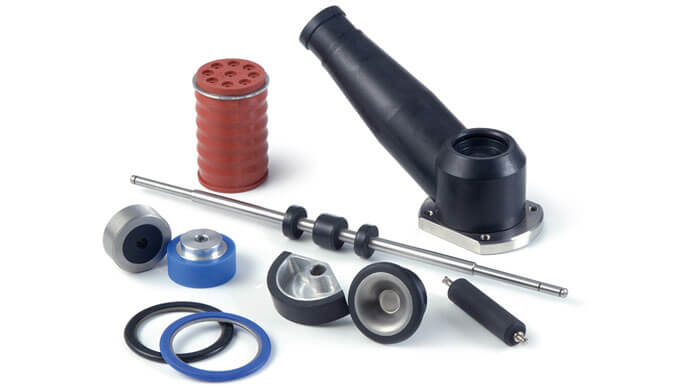Metal-to-rubber bonding, also known as rubber-to-metal bonding or metal-rubber adhesion, is a process that involves attaching or bonding rubber or elastomeric materials to metal surfaces. This combination of materials is commonly used in various industrial applications to take advantage of the unique properties of both rubber and metal.
The rubber provides elasticity, vibration dampening, sealing capabilities, and resistance to certain environmental factors, while the metal provides structural support, rigidity, and durability. Metal-rubber bonded components are often used in industries such as automotive, aerospace, construction, and manufacturing.
The process of metal-to-rubber bonding typically involves several key steps:
- Surface Preparation: The metal surface and the rubber material must be properly prepared before bonding. This usually involves cleaning and degreasing the metal surface to remove contaminants, such as oils, dust, or rust. For the rubber, it may involve surface treatments or priming to enhance adhesion.
- Chemical Priming (Optional): In some cases, a chemical primer may be applied to the metal surface to promote adhesion. The choice of primer depends on the specific metal and rubber materials being used.
- Adhesive Application: A specialized adhesive, often referred to as a bonding agent or adhesive system, is applied to either the metal surface, the rubber, or both. This adhesive is formulated to create a strong bond between the metal and rubber.
- Assembly: The metal and rubber components are assembled together while the adhesive is still in a liquid or semi-liquid state. The components are aligned properly to ensure a secure bond.
- Curing or Vulcanization: The assembly is then subjected to a curing or vulcanization process, which involves applying heat and pressure. The combination of heat and pressure activates the adhesive, causing it to bond the rubber to the metal. The curing process may take place in an oven or through other methods, depending on the adhesive used.
- Cooling and Inspection: After the curing process, the bonded assembly is allowed to cool, and it undergoes quality inspection to ensure that the bond is strong and free from defects.
- Trimming and Finishing (if necessary): Depending on the specific application and design, excess rubber or other finishing processes may be performed to achieve the desired shape and appearance of the bonded component.
- Testing: Metal-to-rubber bonded components often undergo testing to verify their performance, including tests for adhesion strength, durability, and resistance to environmental factors.
The success of the metal-to-rubber bonding process depends on several factors, including the choice of adhesive, the compatibility of the metal and rubber materials, surface preparation, curing conditions, and quality control measures. The selection of the appropriate materials and bonding methods should take into account the specific requirements and performance characteristics of the intended application. Properly bonded metal-rubber components can provide benefits such as improved sealing, reduced vibration, noise reduction, and enhanced durability.
Metal-to-rubber bonding is utilized in a variety of industries where the combination of metal’s structural properties and rubber’s elastomeric properties is required to achieve specific performance characteristics. Some of the industries that commonly use metal-to-rubber bonded components include:
- Automotive: Metal-to-rubber bonding is extensively used in the automotive industry for a wide range of applications, including engine mounts, suspension bushings, exhaust hangers, and vibration dampeners. These components help reduce vibrations, noise, and harshness in vehicles while providing flexibility and durability.
- Aerospace: The aerospace industry uses metal-to-rubber bonding in applications such as aircraft engine mounts, vibration isolators, and aerospace seals. These bonded components are critical for maintaining structural integrity and vibration control in aircraft and spacecraft.
- Construction: Metal-rubber bonded components are found in construction equipment, including excavators, bulldozers, and cranes. They are used in parts such as cab mounts and suspension components to improve operator comfort and reduce vibration.
- Manufacturing and Machinery: Various types of machinery and manufacturing equipment utilize metal-to-rubber bonding for parts like conveyor system components, shock mounts, and industrial seals. These applications enhance equipment performance and reduce wear and tear.
- Marine and Maritime: In the marine industry, metal-rubber bonding is used for applications such as boat and ship engine mounts, hull and deck seals, and vibration dampeners. These components help reduce noise, vibrations, and protect against water intrusion.
- Railway and Mass Transit: Railway and mass transit systems employ metal-to-rubber bonded components in rail car suspension systems, rail pads, and vibration isolators to improve passenger comfort and reduce wear on infrastructure.
- Oil and Gas: In the oil and gas sector, metal-rubber bonded components are used in pumps, pipelines, and offshore equipment to provide sealing and vibration control, especially in harsh environments.
- Renewable Energy: Wind turbine systems utilize metal-to-rubber bonded components in blade root bearings and tower dampeners to reduce vibration and enhance system performance.
- Electronics and Electrical: In electronics and electrical applications, metal-rubber bonding is used in equipment mounts, shock absorbers, and electrical enclosure seals to protect sensitive components and reduce vibrations.
- Medical Devices: Certain medical devices, such as diagnostic equipment and patient beds, incorporate metal-to-rubber bonded components to enhance comfort, reduce vibrations, and ensure proper functioning.
- Mining: Mining equipment employs metal-rubber bonded components in applications like conveyor belts and equipment mounts to enhance durability and reduce vibration.
- Food and Beverage Processing: The food and beverage industry uses metal-to-rubber bonded components in conveyor systems and processing equipment to meet hygiene standards and reduce equipment wear.
These are just some examples of the many industries that benefit from metal-to-rubber bonding. The versatility of this bonding method makes it valuable in applications where the combination of strength, flexibility, vibration control, and durability is required. The specific applications within these industries may vary widely, depending on the equipment and requirements of each sector.


